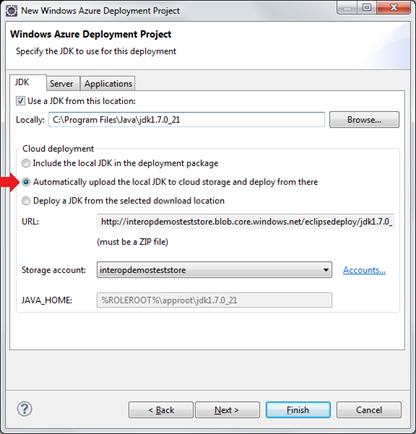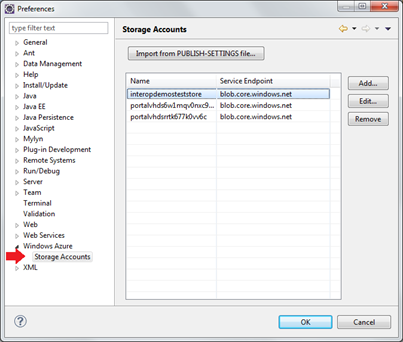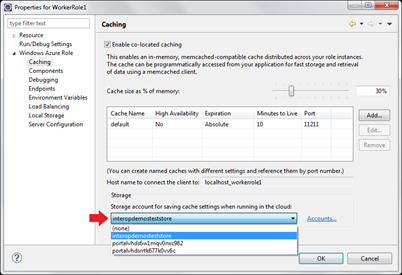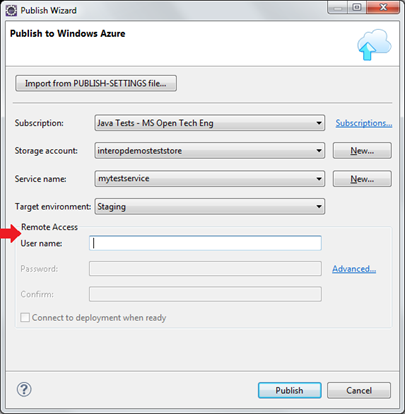If you’re working with Java on Windows Azure, this update is for you!
From:
Martin Sawicki – Principal Program Manager – MS Open Tech
Brian Benz – Sr. Technical Evangelist – MS Open Tech
Incorporating developer feedback and keeping pace with Windows Azure’s ongoing evolution, Microsoft Open Technologies, Inc., has released a new update to the Windows Azure Toolkit for Eclipse. Thislatestversion – the May 2013 Preview(or v2.0.0) – includes a number of new improvements we hope will further simplify your Java work in the Windows Azure cloud. This major update accompanies the release of the Windows Azure SDK v2.0.
Key Enhancements:
Automatic upload of the JDK and Server to Windows Azure storage (and deployment from there)
This new option automaticallyuploads the selected JDK and Web Application Server, when needed, to a selected Windows Azure storage account and deploys these components from that account. This commonly requested feature can greatly enhance the ease and efficiency of deploying the JDK and server components, as well as help with team development scenarios, by avoiding the need to embed these components in the deployment package, or the hassle of manual uploads. Our “Hello World” tutorial walks you through these steps in detail. Here is a screenshot from the updated project creation wizard showing this feature in action:
Centralized storage account tracking
You may be wondering how Windows Azure knows which storage accounts to display in the drop-down list. The answer is another new feature – centralized storage account tracking. In order to reference storage accounts more easily across the various features that rely on storage, like caching and, in this case, the JDK or the Web Application server component deployment, you can register existing storage accounts names and endpoints in your current Eclipse workspace under Preferences > Windows Azure > Storage Accounts:
As usual, you can import the information from your subscription’s publish settings file to provide the storage account discovery magic.
Here’s an example of the centralized storage account tracking for caching as well. The drop down shows you where you would specify which storage account to store credentials for the cache configuration in a Windows Azure role. This way you no longer have to enter the access key manually.
Simplified Remote Access setup
For this release we’ve also streamlined the previous two-step remote access setup into one step. In the “Publish to Cloud” wizard, type in a user name and password to enable remote access, or leave it blank to keep remote access disabled.
By default, Eclipse will use the sample certificate for encrypting your remote access credentials in the Windows Azure configuration file. If you’d rather use your own certificate, choose the Advanced… link.
The “all-in-one” Eclipse library for easier Windows Azure API access now updated with the latest (v0.4.2)
The latest SDK distribution of the Windows Azure Libraries for Java are packaged along with their open-source dependencies as an Eclipse library and referred to as the Package for Windows Azure Libraries for Java (by MS Open Tech) . If your Java code needs to take advantage of the Windows Azure API, just add this library to the build path of your Java project (not the Windows Azure project) and all the needed libraries will be automatically referenced and included in your WAR file.
Additional Enhancements
We’ve also fixed sticky sessions on Windows Server 2012 (previously limited to Windows 2008). And we’ve made some package publish performance improvements that can make the upload portion of the deployment process up to twice as fast as in previous releases, especially helpful if you’re not using the “deploy from download” options, but still embedding large components in the deployment package itself. We’ve also made a number of bug fixes, including some reported issues related to deploying Tomcat and Jetty on Windows 2012 from a cloud download.
Getting the Plugin
Here are the complete instructions to download and install the Windows Azure Plugin for Eclipse with Java, as well as updated documentation.
As always, let us know how the latest release works for you and how you like the new features! To send feedback or questions, just use MSDN Forums or Stack Overflow.




